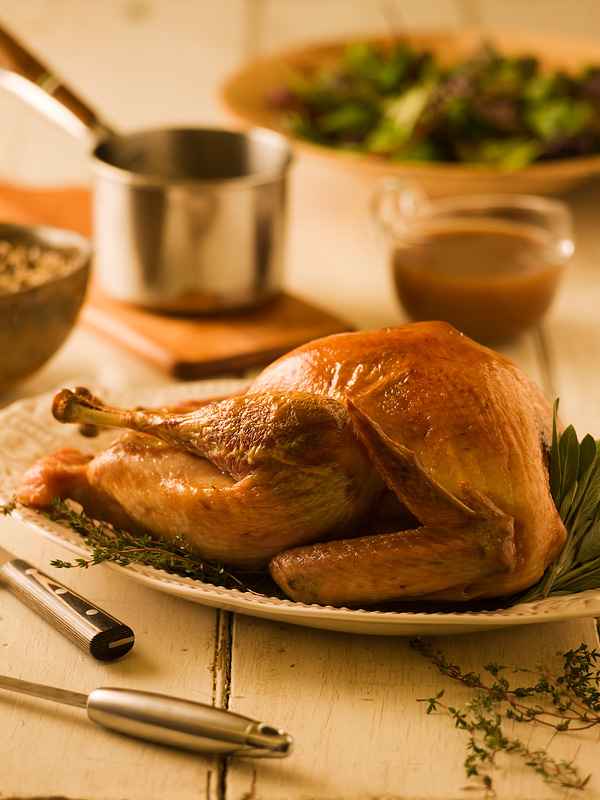What’s the secret for your best-tasting, juiciest holiday turkey ever? Brining is a centuries-old trick that the pros use. Soaking the turkey in salt water is simple and it really works. Brining encourages the tightly wound proteins in the meat to uncoil, bump into each other and form a web of sorts that sets in the heat of the oven, trapping flavourful moisture. Don’t worry though, you don’t have to be a scientist to appreciate how tasty this turkey will be.
Yield: Serves 10 or more
Ingredients
1 10 – 25 pound fresh turkey
2 cups table salt
2 cups brown sugar
2 gallons cold water
4 onions, peeled and halved
4 large carrots
4 stalks celery
1/2 stick butter, melted
lots freshly ground pepper
for the herb gravy
3 cups water, chicken broth or cider
1 cup whatever wine you like
2 tablespoons cornstarch
1 tablespoon minced fresh thyme, tarragon, rosemary or chives
Salt and Pepper
Procedure
Tools needed:
An insulated picnic cooler large enough to submerge the turkey
A few “blue ice” freezer packs, placed in freezer bags to keep packs from being contaminated
A large roasting pan
An accurate meat thermometer to gauge exactly when the turkey is done
For the brined turkey, place the bird upside down in the insulated cooler.
Whisk the salt and sugar in the cold water until they are thoroughly dissolved. Pour this brine over the turkey, turning the bird a few times to mix the salt and sugar thoroughly. If it is not fully submerged, make a bit more brine using the same ratio of salt, sugar and water. Add the freezer packs to the cooler and place in a cool place for 12 hours or overnight.
Preheat the oven to 400 °F (200 °C).
Remove the turkey from the brine and rinse well under cold running water. Thoroughly dry it with paper towels or clean kitchen towels. Remove any excess moisture and dry out the skin so that it will brown well.
With the onions, carrots and celery, fashion a bed in the roasting pan for the turkey to rest on. Brush the turkey thoroughly with the melted butter. Season with lots of freshly ground pepper but not salt; the brine is sufficient for salting.
Roast turkey for 1 hour and then, without opening the oven, turn the heat down to 300 °F (150 °C) and continue roasting for 2 to 3 hours longer, depending on the size of the turkey. This dual-temperature method will first brown the turkey and then slowly finish it so it doesn’t dry out from the initial high heat.
After 2 1/2 hours, open the oven and begin checking the temperature every 15 minutes or so. Continue roasting until the breast and thigh meat have both reached at least 170 °F (77 °C). As a rough guideline you can plan on about 12 minutes cooking time for each pound of turkey.
When done, cover the turkey with foil and let rest for 20 to 30 minutes before carving to give the juices inside the meat a chance to calm down and evenly redistribute themselves throughout the turkey.
For the all-important gravy, pour off most of any accumulated fat, carefully reserving the juices. Add the liquid of your choice to the pan along with the wine and any reserved juices, scraping the bottom of the pan to dissolve all of the browned bits. Pour all of the liquid into a small saucepan, scraping every last bit of flavour out of the pan. Bring it to a simmer.
Dissolve the cornstarch in a splash of water and add to the pan, whisking until the gravy thickens. Whisk in some fresh herbs, then taste, season and enjoy!
Variation
For an extra special treat, you can use apple cider instead of water to brine the turkey. You can also infuse the brine with a few cups of pickling spices by heating it a day or two in advance


